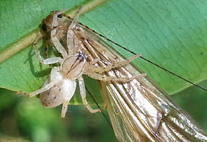Abstract
We review the American spider genus Arachosia O.P.-Cambridge, and present a descriptive taxonomic study with a comparative dichotomous key including 21 species, of which seven are newly described (A. avalosi sp. nov., A. carancho sp. nov., A. kapiipeoi sp. nov., A. magna sp. nov., A. monserrate sp. nov., A. pinhalito sp. nov. and A. tungurahua sp. nov.). Four species names are considered nomina dubia: Oxysoma dubium Berland, Gayenna duplovittata Mello-Leitão, Oxysoma polytrichium Mello-Leitão, and Arachosia sulfurea Mello-Leitão. Arachosia bonneti (Mello-Leitão) is newly synonymized with A. albiventris Mello-Leitão, and A. mezenioides Mello-Leitão with A. freiburgensis Keyserling. Previous problems with the identification of species in a species complex including A. cubana (Banks) are resolved. A disjunct distributional pattern is reported for A. kapiipeoi sp. nov.; a preliminary phylogenetic analysis based on mitochondrial COI sequences shows that these may correspond with two cryptic species. In this contribution, grassland and forests are discussed as the two main habitats inhabited by species of Arachosia. Finally, we propose a hypothesis of matching sexes based on functionality of some genital structures, involving sclerites of the male copulatory organ with structures of the epigyne: the prolateral projection on the primary conductor of the male would have a direct interaction with the lateral projections of the anterior pouch on the median epigynal field of females.

